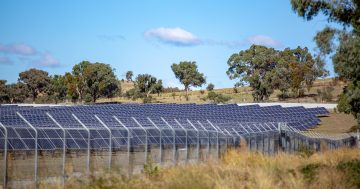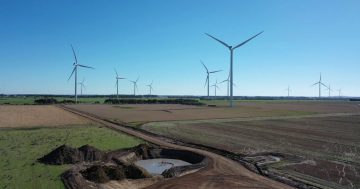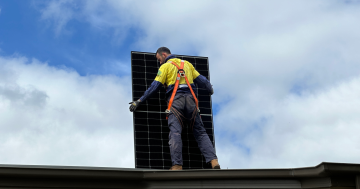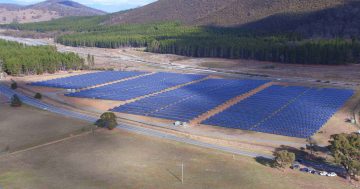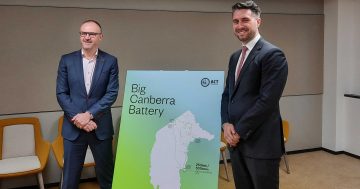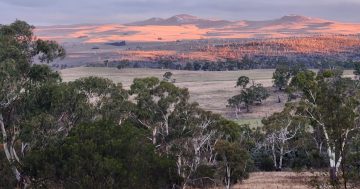
IIG Head of Renewable Energy Infrastructure Lane Crockett and Minister for Climate Change and Sustainability Shane Rattenbury at the opening of the Williamsdale Solar Farm.
The Williamsdale Solar Farm’s almost 36,000 panels are now generating renewable electricity for the ACT after being unveiled yesterday at the 30 hectare facility 20 kilometres south of Canberra.
Owned by the Impact Investment Group, the Williamsdale Solar Farm will generate enough electricity (20,000 megawatt hours per year) to power about 3,400 Canberra homes under its 20-year purchase agreement with the ACT, and help meet the Territory’s goal of 100 per cent renewable electricity by 2020.
Minister for Climate Change and Sustainability Shane Rattenbury said the Williamsdale Solar Farm completed Canberra’s ‘solar highway’ running from the Monaro Highway in the south to the Majura Parkway heading north.
He said that together with Royalla Solar Farm, Mt Majura Solar Farm and Mugga Lane Solar Park, 85,500 megawatt hours per year of renewable electricity will be generated, enough to power about 11,700 homes.
“The future is here, and it is clean, green and renewable. The clean power generated by Williamsdale Solar Farm takes us another significant step towards achieving our target of 100 per cent renewable electricity by 2020 in the ACT,” Mr Rattenbury said.
“The ACT is establishing itself as a world leader when it comes to investment in renewable energy and action on climate change. Already, renewable energy has driven around $500 million of investment into the local economy.
“By 2020, the ACT will produce 100 per cent of our electricity from renewable sources like wind and solar and, by 2050 at the latest, our city will produce zero net greenhouse gas emissions.”
Next year the Sapphire, Hornsdale Stage 2 and Crookwell 2 wind farms will begin generation, with Hornsdale stage 3 beginning generation in 2019.
Mr Rattenbury said the ACT continued to have some of the lowest electricity prices in Australia, with the ACT’s innovative electricity purchasing agreements with 10 wind and solar projects across Australia protecting ACT consumers from high prices during peak events such as heat waves.
“Renewable energy generators receive a set price for the renewable electricity they produce over a 20-year period. What the ACT pays is the difference between this set price and their wholesale market earnings. This means that when wholesale market prices are high, like during a heatwave, instead of ACT consumers paying the solar farms, the solar farms instead pay them,” Mr Rattenbury said.
He also took aim at critics who said renewable electricity generation destabilised the grid.
“Far from being to blame for electricity supply problems during the January 2017 heatwave, in times of peak electricity use, renewable electricity generation like wind and solar were the quiet achievers, helping reduce demand spikes that threatened the stability of the grid in difficult conditions. Three of our large-scale solar farms were generating electricity during the high price spikes experienced during the heatwave,” Mr Rattenbury said.
IIG head of renewable energy infrastructure Lane Crockett said: “The smartest investors and developers in the country aren’t trying to eke another few years out of old unreliable, polluting coal-fired infrastructure. They are building the clean generators that will deliver reliable electricity, crucial environmental benefits, health benefits and attractive financial returns. Meanwhile, our investors have confidence knowing that the ACT Government has committed to buying the farm’s electricity for 20 years.”
The Williamsdale Solar Farm’s 35,540 photovoltaic panels are mounted on a single-axis tracking system that keeps them facing the sun as it moves through the day, which improves panel efficiency by up to 30 per cent.
IIG has calculated that the Williamsdale Solar Farm should save about 17,250 tonnes of carbon emissions a year, and about 431,000 tonnes over its lifetime.
IIG’s Solar Income Fund was launched in August 2016 with the capital raised in less than a week. Future Super, Australia’s first 100 per cent fossil fuel free super fund, is a key investor in IIG’s Solar Income Fund.
Future Super managing director Simon Sheikh said the 20-year power purchase agreement would provide a reliable, long-term income stream for the Future Super portfolio and other investors in the IIG Solar Income Fund.
“Our investment demonstrates the important role superannuation can play in upgrading Australia’s grid to 100 per cent renewable energy,” he said.
IIG has also developed a pipeline of new solar farms in preparation for launching a second solar energy investment fund later in the financial year.











